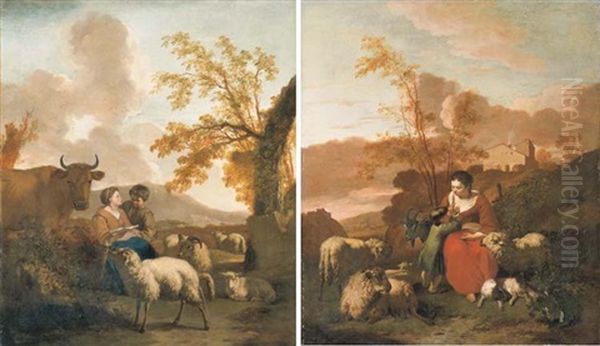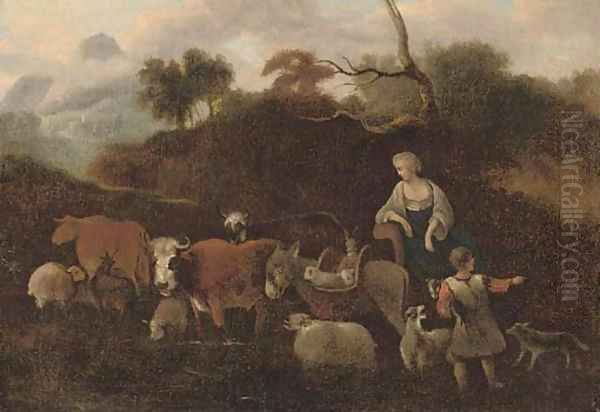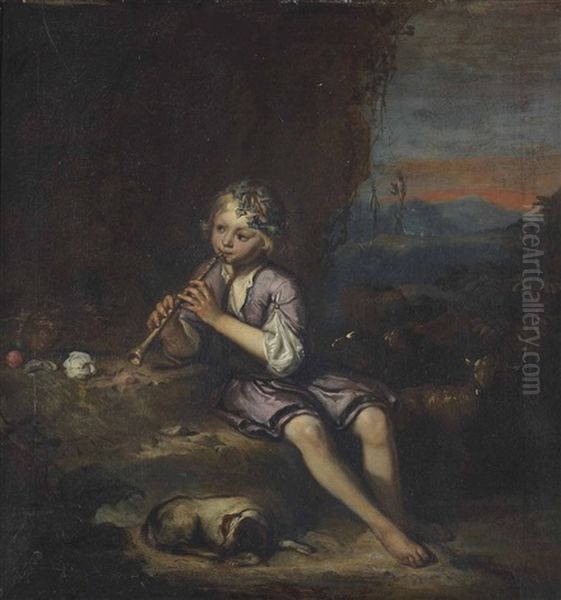Simon van der Does (1653-1717) was a notable Dutch Golden Age painter, recognized primarily for his charming pastoral landscapes, often populated with shepherds, shepherdesses, and their gentle flocks. Born into an artistic family in Amsterdam, he carved out a career during a period of immense artistic production and innovation in the Netherlands. While perhaps not reaching the towering fame of contemporaries like Rembrandt or Vermeer, Simon van der Does holds a significant place among the Dutch Italianate painters, artists who brought a sunnier, more idealized vision of the landscape to the Northern European art scene.
Early Life and Artistic Lineage
Simon van der Does was born in Amsterdam in 1653. His artistic journey began under the most intimate of tutelages, that of his father, Jacob van der Does (c. 1623–1673). Jacob was himself a respected landscape painter, known for his Italianate scenes, often featuring sheep and goats in sun-drenched, somewhat rugged settings, influenced by artists like Pieter van Laer, one of the original "Bamboccianti" – Dutch and Flemish painters active in Rome who depicted everyday life. This paternal guidance undoubtedly instilled in Simon an early appreciation for pastoral themes and the allure of the Italian countryside, even if experienced vicariously through art.
The artistic environment of Amsterdam during Simon's formative years was incredibly rich. The Dutch Republic was at the zenith of its economic and cultural power, and art patronage was widespread. Young Simon would have been exposed to a vast array of styles and subjects, from the meticulous still lifes of Willem Kalf to the dramatic seascapes of Ludolf Bakhuizen and the serene domestic interiors of Pieter de Hooch. This vibrant atmosphere provided a fertile ground for any aspiring artist.
Further Training and Influences

Beyond his father's studio, Simon van der Does sought further instruction to refine his skills. He became a pupil of Adriaen van de Velde (1636–1672), a highly esteemed and exceptionally gifted painter of landscapes, animals, and figures. Adriaen van de Velde was renowned for his elegant compositions, his masterful rendering of animals, particularly cattle and sheep, and the delicate, silvery light that bathed his scenes. His influence on Simon is palpable in the younger artist's attention to animal anatomy and the gentle, idyllic mood that pervades many of his works. Adriaen van de Velde himself was a versatile artist, also producing beach scenes and religious subjects, showcasing a breadth that was common among successful painters of the era.
Another significant figure mentioned in relation to Simon's development is Karel du Jardin (1622–1678). Like Adriaen van de Velde, Du Jardin was a prominent Italianate landscape painter. His works are characterized by a warm, golden light, clear compositions, and beautifully rendered figures and animals, often set against a backdrop of classical ruins or rolling Italian hills. The influence of artists like Du Jardin and Nicolaes Berchem (1620–1683), another leading Italianate master whose prolific output of sunny landscapes filled with peasants and livestock was immensely popular, helped to solidify this particular subgenre within Dutch art.
Some sources also suggest a connection with Gerard de Lairesse (1641–1711), a painter and art theorist known for his classicizing style, influenced by French academic art and Poussin. If Simon did study with Lairesse, it would have exposed him to a more theoretical and classically oriented approach to art, which might have informed his figure drawing and compositional strategies, though his primary output remained firmly within the pastoral landscape tradition.
Career Path and Travels
Simon van der Does's early career saw him based in Amsterdam. He is recorded as having spent a year in Friesland, a northern province of the Netherlands. This period might have offered him different landscape motifs, perhaps more rustic and less overtly Italianate than those he would later favor, though specific works from this Friesland sojourn are not clearly identified.
Later, his professional journey took him beyond the borders of the Dutch Republic. He worked for a time in Brussels and Antwerp, major artistic centers in the Southern Netherlands (Flanders). Antwerp, in particular, had a storied artistic legacy, being the city of Peter Paul Rubens (1577–1640) and Anthony van Dyck (1599–1641). While the high Baroque dynamism of Rubens might seem distant from Simon's gentler style, the artistic currents and patronage systems in these cities would have offered new experiences and opportunities. It's possible he encountered the works of Flemish landscape and genre painters like David Teniers the Younger (1610–1690), whose peasant scenes were highly sought after.

Despite these travels, Simon van der Does eventually returned and settled in Amsterdam, where he continued his career. He also reportedly worked in The Hague for a period, a city that was not only the political center of the Republic but also a hub for artists and patrons.
Artistic Style and Characteristics
Simon van der Does is best categorized as an Italianate landscape painter. This style, popular in the Netherlands from the mid-17th century onwards, involved depicting landscapes that evoked the light, atmosphere, and scenery of Italy, often without the artist ever having traveled there. These scenes were typically idealized, featuring warm sunlight, picturesque ruins, and pastoral figures. Artists like Jan Both (c. 1610/18–1652) and Jan Asselijn (c. 1610–1652) were pioneers of this style, bringing back sketches and a new sensibility from their travels south of the Alps.
Simon's works generally follow this tradition. His paintings often feature a soft, diffused light, creating a tranquil and harmonious atmosphere. While he inherited his father's interest in pastoral subjects, Simon's touch is often described as somewhat softer and perhaps more refined, likely a result of his training with Adriaen van de Velde. His compositions are typically well-balanced, with a careful arrangement of figures, animals, and landscape elements.
In his depiction of animals, particularly sheep and cattle, Simon shows a clear understanding of their anatomy and behavior, a hallmark of the best Dutch animal painters like Paulus Potter (1625–1654), whose "The Young Bull" remains an icon of Dutch art, or Aelbert Cuyp (1620–1691), famous for his luminous depictions of cattle in riverside landscapes bathed in golden light. While Simon's animals might not always possess the robust naturalism of Potter or the atmospheric glow of Cuyp, they are rendered with care and contribute significantly to the idyllic charm of his scenes.
A characteristic noted by some art historians is that the figures in Simon van der Does's paintings often play a more prominent role than in the works of some other landscape specialists. His shepherds and shepherdesses are not mere staffage but are integral to the narrative and mood of the piece. This focus on the human element within the pastoral setting aligns him with artists who successfully blended figure and landscape painting.

Compared to the more rugged or dramatic Italianate landscapes of artists like Salvator Rosa (1615-1673), whose wild scenes were also influential, Simon van der Does favored a more serene and bucolic vision. His Italy is a land of gentle hills, peaceful meadows, and contented shepherds, a dreamlike Arcadia rather than a wilderness. Some critics have suggested that while his works are pleasing and demonstrate skill, they occasionally lack the profound emotional depth or the sheer technical brilliance found in the oeuvres of the very top tier of Dutch masters. Nevertheless, his contribution to the Italianate genre is undeniable, and his paintings were appreciated for their charm and decorative qualities.
Key Themes and Subjects
The predominant themes in Simon van der Does's work revolve around pastoral life. Shepherds, shepherdesses, sheep, goats, and cattle are his most frequent subjects, set within idealized landscapes that often include classical architectural elements or ruins, hinting at the Italian setting.
Shepherds and Shepherdesses: These figures are often depicted at rest, engaged in simple activities like reading, conversing, or tending to their flocks. They embody a peaceful, rustic existence, far removed from the bustle of city life.
Animal Painting: His skill in rendering animals was central to his art. The gentle demeanor of his sheep and the placid nature of his cattle contribute to the overall tranquility of his scenes.
Idyllic Landscapes: The settings are crucial. Rolling hills, leafy trees, calm bodies of water, and a warm, inviting light create a sense of harmony and escape. These are not specific, topographically accurate locations but rather imagined idealizations.
Influence of the "Bamboccianti": While his father was more directly linked to the Bamboccianti style, elements of their interest in everyday rural life can be seen in Simon's focus on humble pastoral figures, albeit in a more classicized and less gritty manner than, for example, Pieter van Laer or Jan Miel.
Representative Works
Several works by Simon van der Does are held in public collections, notably in the Amsterdam Museum (which holds works formerly in the Rijksmuseum's collection or city collections). These provide good examples of his style and thematic concerns:
_Shepherds Reading_ (1706): This painting likely depicts a shepherd and perhaps a shepherdess in a moment of quiet contemplation or shared leisure, set within a characteristic pastoral landscape. The act of reading suggests a degree of literacy or a romanticized view of pastoral life, common in Arcadian imagery.
_Shepherdess_ (1708): A work focusing on a female pastoral figure, this painting would showcase his ability to render figures and integrate them harmoniously with their surroundings. The shepherdess motif was popular, often imbued with connotations of innocence and natural beauty.

_Maternal Love_ (1714): This title suggests a scene with a mother and child, possibly within a pastoral context, or perhaps a more allegorical representation of maternal affection. If set in a landscape with animals, it could depict a ewe with her lamb or a cow with her calf, drawing parallels between human and animal affection, a theme that would resonate with the sentimental tastes of the period.
_Herds of Cattle and Buffaloes_ (general description): While "buffaloes" might be a slight misnomer for European settings (perhaps referring to robust breeds of cattle or water buffalo if an exotic touch was intended), this description points to his specialization in depicting groups of livestock. Such paintings would emphasize his skill in animal portraiture and in creating dynamic yet peaceful group compositions.
His works can also be found in other European collections, and occasionally appear at auction, allowing for continued appreciation of his contribution to Dutch art. Each piece typically showcases his careful technique, his pleasant color palette, and his consistent dedication to the pastoral ideal.
Contemporaries and the Artistic Milieu of the Late Dutch Golden Age
Simon van der Does worked during the latter part of the Dutch Golden Age, a period that, while still vibrant, saw shifts in taste and patronage. The initial boom of the mid-17th century, which saw artists like Rembrandt van Rijn (1606-1669), Johannes Vermeer (1632-1675), and Frans Hals (c. 1582/83–1666) produce their masterpieces, was evolving. There was a growing taste for more refined, elegant, and often smaller-scale works.
The Italianate landscape painters, including Simon, catered to this demand for pleasant, decorative pictures that could adorn the homes of wealthy burghers. Besides those already mentioned (Berchem, Du Jardin, Adriaen van de Velde, Both, Asselijn), other artists working in similar veins included Adam Pynacker (1622–1673), known for his sun-drenched Italian scenes with feathery trees, and Willem de Heusch (1625-1692).
In the broader landscape genre, artists like Jacob van Ruisdael (c. 1628–1682) and Meindert Hobbema (1638–1709) continued to depict the native Dutch countryside with profound sensitivity, offering a contrast to the Italianates. Ruisdael’s dramatic skies and wooded scenes, and Hobbema’s charming village views, represented a different but equally important facet of Dutch landscape art.
Figure and genre painting also continued to flourish with artists like Jan Steen (c. 1626–1679), known for his lively and often humorous depictions of everyday life, and Gabriel Metsu (1629–1667), whose refined genre scenes were highly prized. Simon van der Does, with his emphasis on figures within his landscapes, operated in a space that bridged pure landscape and genre painting.
Later Life and Legacy
Simon van der Does passed away in 1717, reportedly in Antwerp, though some sources suggest Amsterdam. He was 64 years old. His life spanned a period of significant artistic achievement in the Netherlands. While he may not have been an innovator on the scale of some of his predecessors or contemporaries, he was a skilled and dedicated practitioner of the Italianate landscape tradition.
His legacy lies in his contribution to this specific genre. His paintings offered patrons an escape to an idealized, sunnier world, a vision of pastoral tranquility that held enduring appeal. His works are valued for their charm, their competent execution, and their representation of a particular taste in 17th and early 18th-century Dutch art.
Today, Simon van der Does is considered one of the many talented "minor masters" of the Dutch Golden Age. This term is not derogatory but rather reflects the incredible depth of artistic talent present in the Netherlands during this period. His paintings can be found in museums and private collections, serving as a testament to his skill and the enduring popularity of the pastoral idyll in art. He successfully carried on the artistic traditions of his father and his teachers, creating a body of work that, while perhaps modest in comparison to the giants of the era, remains a pleasing and valuable part of Dutch art history. His dedication to the gentle beauty of the pastoral landscape ensures his continued, albeit quiet, recognition.